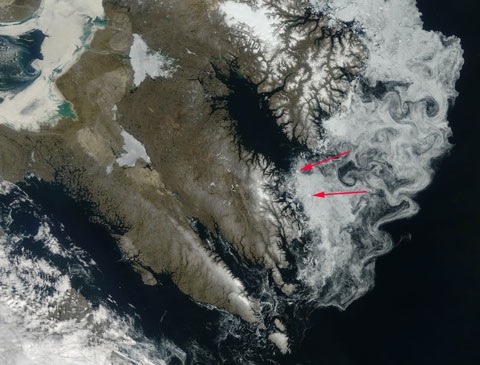 Connie Hedegaard, the livewire Danish Minister for Climate and Energy (yes they are twinned in Denmark – would that they still were in NZ), will not be to blame if the Copenhagen talks, which she is to host, founder. I have been watching the BBC’s Hard Talk programme the last couple of evenings. Interviewer Stephen Sackur has been to Greenland, to Ilulissat, where Hedegaard had invited some 30 ministers on climate change to an informal conference at a place where the effects of global warming on Greenland ice flow are all too apparent. She explained to Sackur in the excerpt from this interview  (second clip down the page – the first is only introductory) her hope that, in remote and secluded Ilulissat, the ministers, working in the knowledge that everything was off the record, would find some trust and common ground. Continue reading “Ice concentrates ministerial minds”
Connie Hedegaard, the livewire Danish Minister for Climate and Energy (yes they are twinned in Denmark – would that they still were in NZ), will not be to blame if the Copenhagen talks, which she is to host, founder. I have been watching the BBC’s Hard Talk programme the last couple of evenings. Interviewer Stephen Sackur has been to Greenland, to Ilulissat, where Hedegaard had invited some 30 ministers on climate change to an informal conference at a place where the effects of global warming on Greenland ice flow are all too apparent. She explained to Sackur in the excerpt from this interview  (second clip down the page – the first is only introductory) her hope that, in remote and secluded Ilulissat, the ministers, working in the knowledge that everything was off the record, would find some trust and common ground. Continue reading “Ice concentrates ministerial minds”
Tag: Greenland
Wouldn’t it be ice
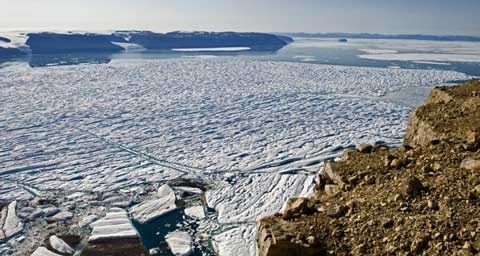
Pictures from my new favourite blog, Meltfactor.org, where Jason Box of the Byrd Polar Research Centre at Ohio State is posting from the Greenpeace expedition to the Petermann glacier in NW Greenland. The pictures are stunning (above shows fracturing on the end of the ice tongue) — and the insight to what’s going up there as the Arctic melts is fascinating. And, just to make every photographer jealous, they get to fly over pods of narwhals (including two young ‘uns, I reckon)…
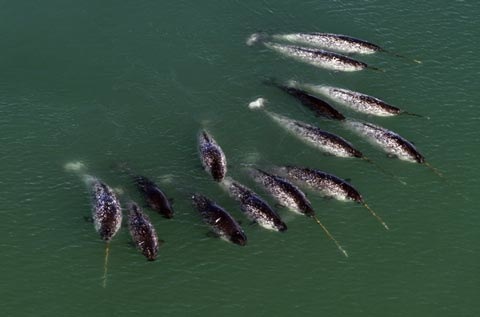
On an island
NASA’s Earth Observatory is without doubt one of my favourite web sites. As I write, the above view of sea ice off Baffin Island (or a version of it) is their Image of the Day, and aside from the obvious beauties of the swirls of melting sea ice (memorably described in a comment at RealClimate as “frappucino”), I reckon you can make out the two chunks of last year’s Petermann Ice Island that I blogged about last week. My two red arrows mark the huge relict chunks of ice shelf. Click on the image (or here) for the full NASA version (about 3.5MB), and then go and look at the icebergs pouring out of the fjords on Greenland’s west coast (top right of the big picture). Dramatic and lovely, and frightening at the same time.
In other Arctic news, there are a new set of forecasts for this year’s minimum at the SEARCH Sea Ice Outlook site: most teams are picking a result somewhere between 2007 and 2008, but two of the sea ice modelling efforts are still suggesting a new record is possible. The NSIDC’s July 22nd update notes that 2009’s melt is now running ahead of 2008, and looking at their daily graph of extent, the current rate of melt seems to be faster than 2007. This has prompted some speculation about when the NE and NW Passages might open. Scanning the Cryosphere Today and University of Bremen maps, it looks as though the NE Passage (above Russia) might open soon. Blue colours on the CT image correspond the ice swirls on the NASA image above, and there’s still plenty of melt season to run. The NW Passage doesn’t look as sure a prospect: I think it could open, but perhaps only on the northern route. We live in interesting times…
Plus: great images of the Petermann Ice Tongue from the Greenpeace science team up there at the moment at the Guardian and Discovery Channel. Not to be missed.
First we lose Manhattan…
It looks as though the Petermann Ice Tongue in northern Greenland is about to lose another major chunk of ice. This New Scientist video (accompanying text here) shows a team working on the tongue, documenting events as they happen. They expect a major break-up event within weeks:
When this happens, an island of ice the size of Manhattan, spanning 100 km2 holding 5 billion tonnes of ice, will break free and drift out to sea.
Researchers are concerned that the loss of this huge mass of ice might “uncork” the glacier, leading to a speed up and further ice loss.
Last year’s ice island started out at 25 km2, but has moved an amazing distance since it broke off in July 2008. By September it had moved south through Nares Strait (between Greenland and Ellesmere Island), and at that point the Canadian Ice Service installed a GPS tracking beacon. The ice island is now down to 21 km2 in area, drifting off the SE coast of Baffin Island. The massive berg has its own regularly updated page at the Canadian Ice Service (with satellite imagery), and you can follow its daily position here. I wonder how far a new Manhattan-sized island might get…
Meanwhile, the Telegraph reports that huge blobs of organic “goo” up to 15 miles long are appearing in the Chuckchi Sea and to the north of Alaska.
The US Coast Guard told the Anchorage Daily News that the strange find is not an oil product or a hazardous substance of any kind.
“It’s definitely, by the smell and make-up of it, some sort of naturally occurring organic or otherwise marine organism,” said Petty Officer 1st Class Terry Hasenauer. In recent history I don’t think we’ve seen anything like this,” he added.
Results of an analysis are expected next week
Gone too soon
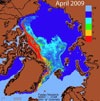 The June Sea Ice Outlook forecasts for the Arctic sea ice September minimum extent have been released today by SEARCH. Most groups are picking a minimum close to last year’s 4.7m km2, but the melt season is starting with an unusually small amount of multi-year ice. The report suggests that there is “a small but important probability of a major sea ice loss event this year, given that the ice is thinner and younger than previous years, combined with a possibility of atmospheric conditions that cause significant ice retreat.” The full range of forecasts is shown in this chart:
The June Sea Ice Outlook forecasts for the Arctic sea ice September minimum extent have been released today by SEARCH. Most groups are picking a minimum close to last year’s 4.7m km2, but the melt season is starting with an unusually small amount of multi-year ice. The report suggests that there is “a small but important probability of a major sea ice loss event this year, given that the ice is thinner and younger than previous years, combined with a possibility of atmospheric conditions that cause significant ice retreat.” The full range of forecasts is shown in this chart:
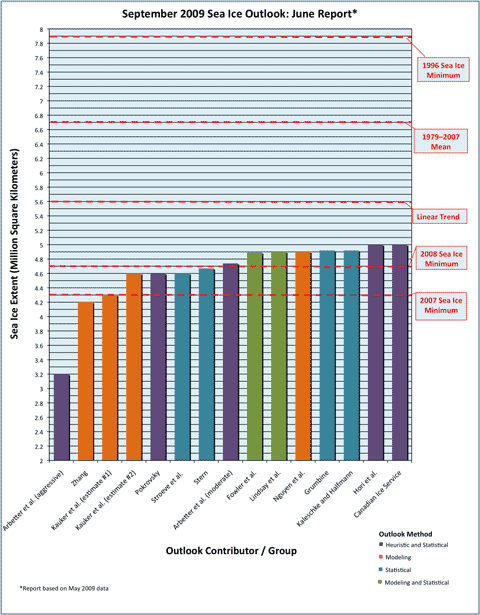
The range of individual outlook values is from 4.2 to 5.0 million square kilometers. All estimates are well below the 1979–2007 September climatological mean value of 6.7 million square kilometers. Half of the responses are in the range of 4.9–5.0 million square kilometers; the remaining estimates are in the range of 4.2–4.7 (Figure 1, above). The uncertainty / error values, from those groups that provided them, are close to 0.5 million square kilometers, thus many of the values overlap.
Interestingly, the forecasts showing the lowest minima are based on sea ice modelling driven by atmospheric forcings and initialised with current sea ice conditions. The projection by Jinlun Zhang (next to lowest in the chart) suggests that even with conditions like last year — that is, without the Transpolar Express of warm southerlies that set up in 2007 — the 2007 record could fall. On the other hand, a Russian scientist suggest thats Pacific sea surface temps could be priming a cooler pattern than last year.
The full report [PDF] is a very interesting read for all ice watchers (and gamblers). On this guide to the form, it looks as though I’ll lose my bets – but the weather over the next two months will be the deciding factor. Do I feel lucky…?

